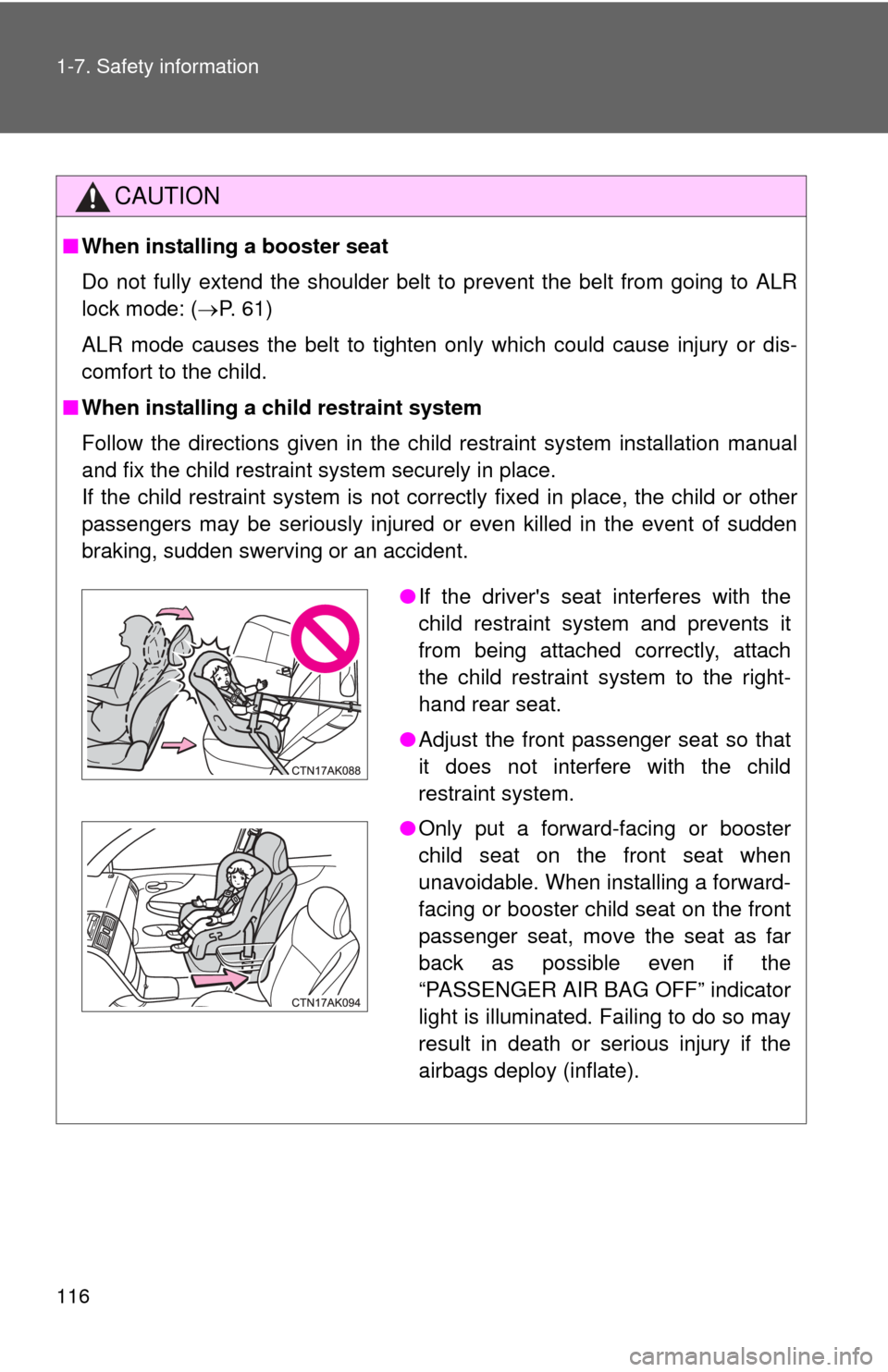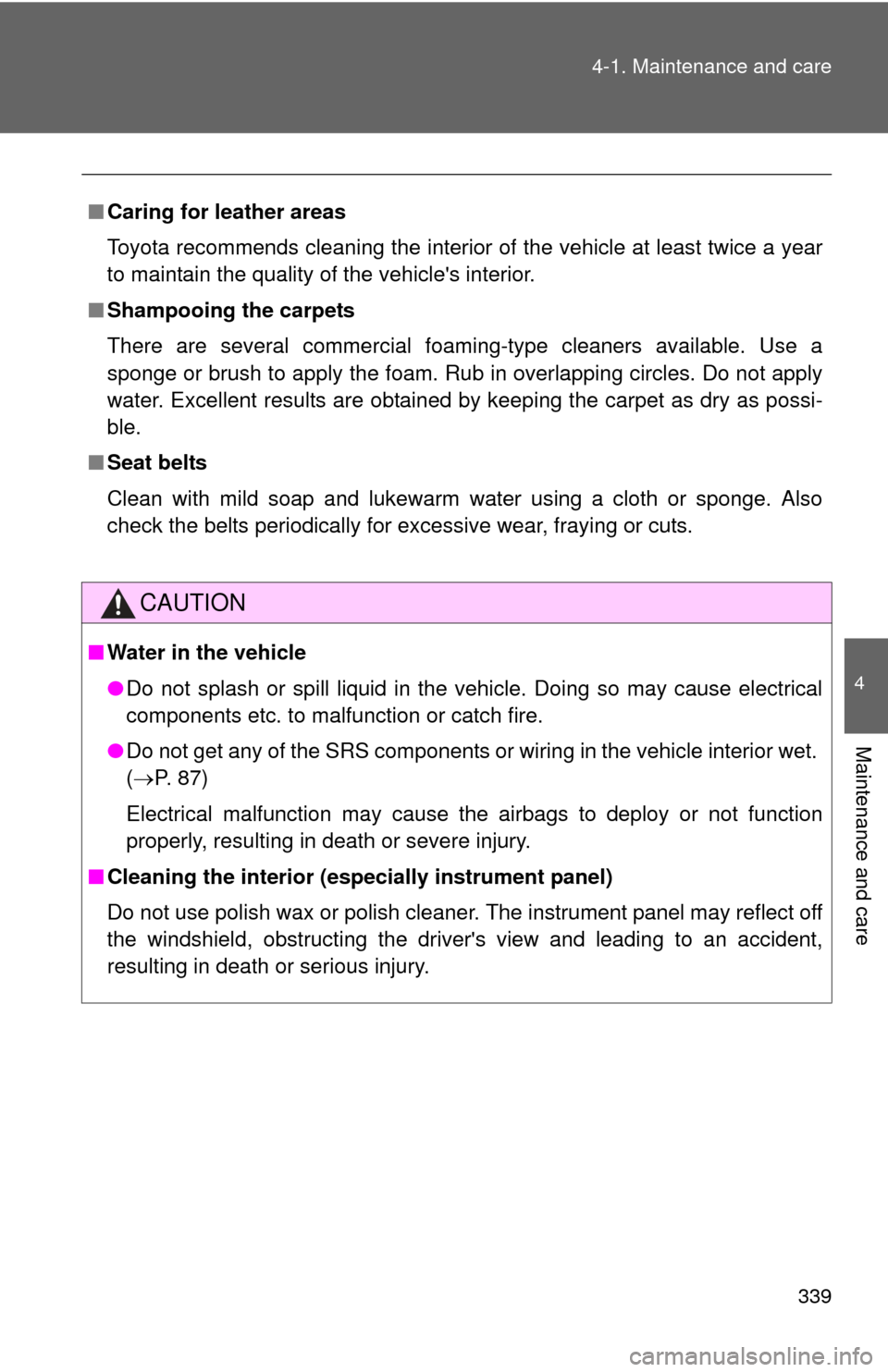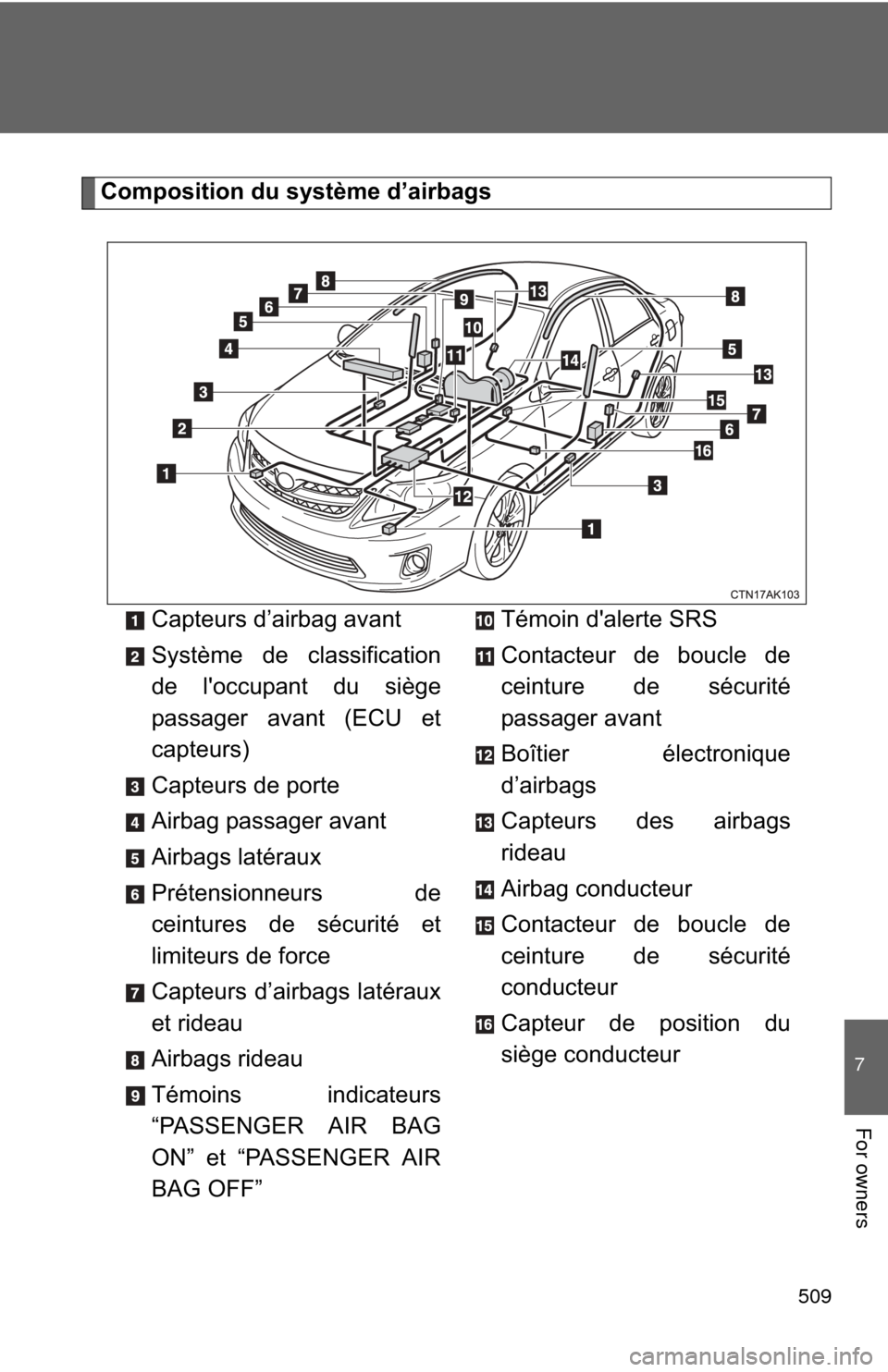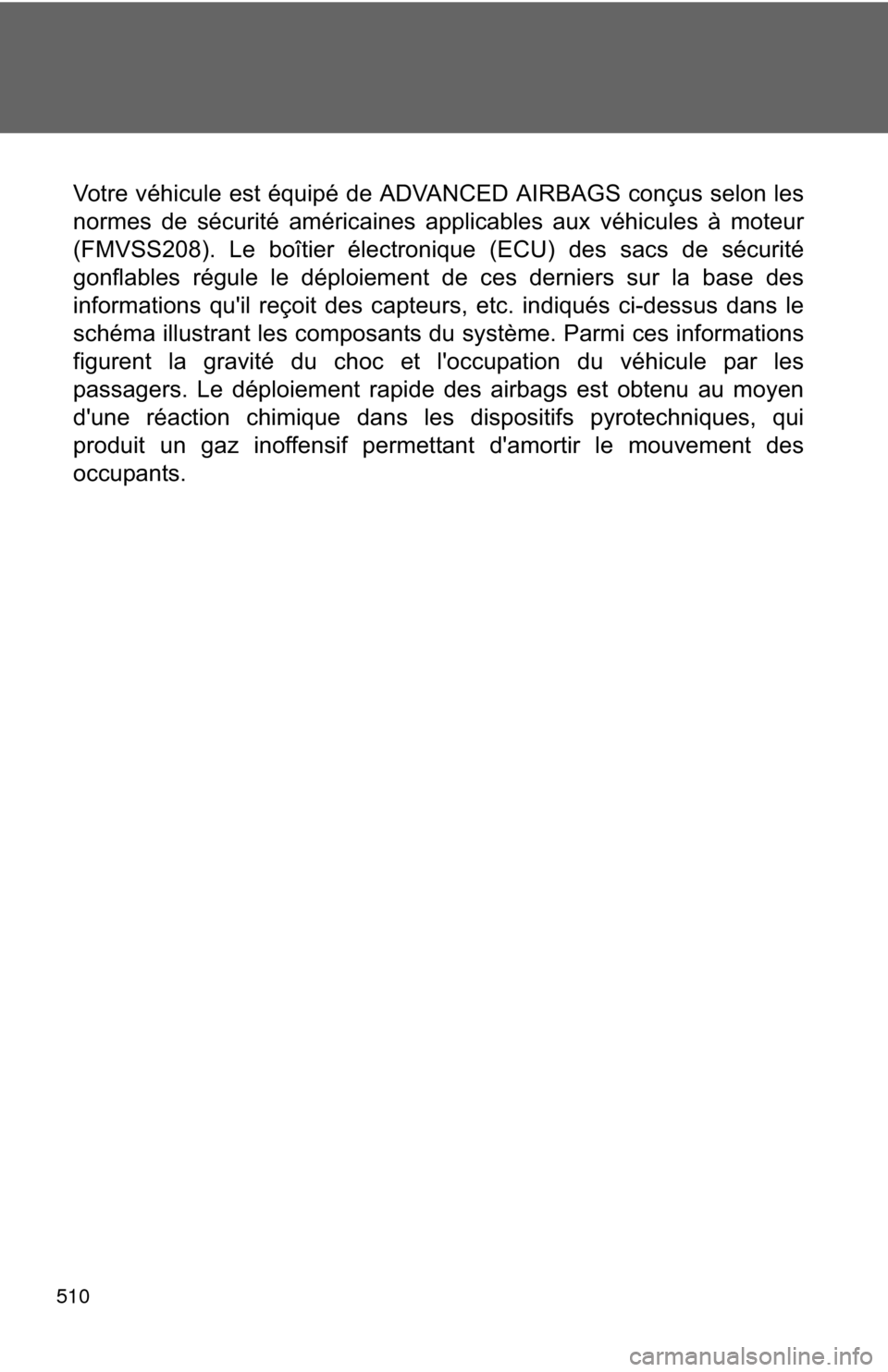2013 TOYOTA COROLLA airbag off
[x] Cancel search: airbag offPage 102 of 532

102 1-7. Safety information
CAUTION
■Front passenger occupant cl assification system precautions
● Do not recline the front passenger seatback so far that it touches a rear
seat. This may cause the “PASSENGER AIR BAG OFF” indicator light to
be illuminated, which indicates that the passenger’s airbags will not deploy
in the event of a severe accident. If the seatback touches the rear seat\
,
return the seatback to a position where it does not touch the rear seat.
Keep the front passenger seatback as upright as possible when the vehi-
cle is moving. Reclining the seatback excessively may lessen the effec-
tiveness of the seat belt system.
● If an adult sits in the front passenger seat, the “PASSENGER AIR BAG
ON” indicator light is illuminated. If the “PASSENGER AIR BAG OFF” indi-
cator is illuminated, ask the passenger to sit up straight, well back in the
seat, feet on the floor, and with the seat belt worn correctly. If the
“PASSENGER AIR BAG OFF” indicator still remains illuminated, either
ask the passenger to move to the rear seat, or if that is not possible, move
the front passenger seat fully rearward.
● When it is unavoidable to install the forward-facing child restraint system
on the front passenger seat, install the child restraint system on the front
passenger seat in the proper order. (P. 107)
● Do not modify or remove the front seats.
● Do not kick the front passenger seat or subject it to severe impact. Other-
wise, the SRS warning light may come on to indicate a malfunction of the
detection system. In this case, contact your Toyota dealer immediately.
● Child restraint systems installed on the rear seat should not contact the
front seatbacks.
● Do not use a seat accessory, such as a cushion or seat cover, that covers
the seat cushion surface.
● Do not modify or replace the upholstery of the front seat.
Page 105 of 532

105
1-7. Safety information
1
Before driving
■
Selecting an appropriat e child restraint system
● Use a child restraint system appropriate for the child until the child
becomes large enough to properly wear the vehicle’s seat belt.
● If a child is too large for a child restraint system, sit the child on a rear
seat and use the vehicle's seat belt. ( P. 58)
CAUTION
■Child restraint precautions
●For effective protection in automobile accidents and sudden stops, a child
must be properly restrained, using a seat belt or child restraint system
depending on the age and size of the child. Holding a child in your arms is
not a substitute for a child restraint system. In an accident, the child can be
crushed against the windshield, or between you and the vehicle's interior.
● Toyota strongly urges the use of a proper child restraint system that con-
forms to the size of the child, installed on the rear seat. According to acci-
dent statistics, the child is safer when properly restrained in the rear seat
than in the front seat.
● Never install a rear-facing child restraint system on the front passenger
seat even if the “PASSENGER AIR BAG OFF” indicator light is illuminated.
In the event of an accident, the force of the rapid inflation of the front pas-
senger airbag can cause death or serious injury to the child if the rear-fac-
ing child restraint system is installed on the front passenger seat.
● A forward-facing child restraint system may be allowed to be installed on
the front passenger seat only when it is unavoidable. A child restraint sys-
tem that requires a top tether strap should not be used in the front passen-
ger seat since there is no top tether strap anchor for the front passenger
seat. Adjust the seatback as uprights as possible and always move the
seat as far back as possible even if the “PASSENGER AIR BAG OFF”
indicator light is illuminated, because the front passenger airbag could
inflate with considerable speed and force. Otherwise, the child may be
killed or seriously injured.
Page 116 of 532

116 1-7. Safety information
CAUTION
■When installing a booster seat
Do not fully extend the shoulder belt to prevent the belt from going to ALR
lock mode: ( P. 61)
ALR mode causes the belt to tighten only which could cause injury or dis-
comfort to the child.
■ When installing a child restraint system
Follow the directions given in the child restraint system installation manual
and fix the child restraint system securely in place.
If the child restraint system is not correctly fixed in place, the child or other
passengers may be seriously injured or even killed in the event of sudden
braking, sudden swerving or an accident.
●If the driver's seat interferes with the
child restraint system and prevents it
from being attached correctly, attach
the child restraint system to the right-
hand rear seat.
● Adjust the front passenger seat so that
it does not interfere with the child
restraint system.
● Only put a forward-facing or booster
child seat on the front seat when
unavoidable. When installing a forward-
facing or booster child seat on the front
passenger seat, move the seat as far
back as possible even if the
“PASSENGER AIR BAG OFF” indicator
light is illuminated. Failing to do so may
result in death or serious injury if the
airbags deploy (inflate).
Page 155 of 532

155
2-2. Instrument cluster
2
When driving
CAUTION
■
If a safety system warning light does not come on
Should a safety system light such as the ABS or SRS airbag warning light
not come on when you start the engine, this could mean that these systems
are not available to help protect you in an accident, which could result in
death or serious injury. Have the vehicle inspected by your Toyota dealer
immediately if this occurs.
■ Warning lights
Warning lights inform the driver of malfunctions in any of the
vehicle’s systems. ( P. 424)
*1: These lights turn on when the “ENGINE START STOP” switch is
turned to IGNITION ON mode (vehicles with smart key system) or
the engine switch is turned to
the “ON” position (vehicles without
smart key system) to indicate that a system check is being per-
formed. They will turn off after the engine is started, or after a few
seconds. There may be a malfunction in a system if a light does not
come on, or if the lights do not turn off. Have the vehicle inspected
by your Toyota dealer for details.
*2: The light flashes to indicate a malfunction.
(Canada)(U.S.A.)(Canada)(U.S.A.)(Canada)
(U.S.A.)(U.S.A.)(U.S.A.)(if equipped)(Canada)
(on the
instrument
cluster)(on the center
panel)(if equipped)
*1*1*1*1*1*1*1*1
*1*1*1*1*1*2
Page 339 of 532

339
4-1. Maintenance and care
4
Maintenance and care
■
Caring for leather areas
Toyota recommends cleaning the interior of the vehicle at least twice a year
to maintain the quality of the vehicle's interior.
■ Shampooing the carpets
There are several commercial foaming-type cleaners available. Use a
sponge or brush to apply the foam. Rub in overlapping circles. Do not apply
water. Excellent results are obtained by keeping the carpet as dry as possi-
ble.
■ Seat belts
Clean with mild soap and lukewarm water using a cloth or sponge. Also
check the belts periodically for excessive wear, fraying or cuts.
CAUTION
■Water in the vehicle
●Do not splash or spill liquid in the vehicle. Doing so may cause electrical
components etc. to malfunction or catch fire.
● Do not get any of the SRS components or wiring in the vehicle interior wet.
( P. 8 7 )
Electrical malfunction may cause the airbags to deploy or not function
properly, resulting in death or severe injury.
■ Cleaning the interior (esp ecially instrument panel)
Do not use polish wax or polish cleaner. The instrument panel may reflect off
the windshield, obstructing the driver's view and leading to an accident,
resulting in death or serious injury.
Page 429 of 532

5
When trouble arises
429
5-2. Steps to take in an emergency
■
SRS warning light
This warning light system monitors the airbag sensor assembly, front airbag
sensors, side and curtain shield airbag sensors, curtain shield airbag sen-
sors, door sensors, driver's seat position sensor, driver's seat belt buckle
switch, front passenger occupant classification system (ECU and sensors),
“PASSENGER AIR BAG ON” indicator light, “PASSENGER AIR BAG OFF”
indicator light, front passenger's seat belt buckle switch, seat belt preten-
sioners and force limiters, airbags, interconnecting wiring and power
sources. ( P. 8 6 )
■ Front passenger detection sensor and passenger seat belt reminder
● If luggage is placed on the front passenger seat, the front passenger
detection sensor may cause the warning light to flash, even if a passen-
ger is not sitting in the seat.
● If a cushion is placed on the seat, the sensor may not detect a passen-
ger, and the warning light may not operate properly.
■
When the tire pressure warning light comes on
Check the tire inflation pressure and adjust to the appropriate level.
Pushing the tire pressure warning reset switch does not turn off the tire
pressure warning light.
■The tire pressure warning light may turn on due to natural causes
The tire pressure warning light may turn on due to natural causes such
as natural air leaks or tire inflation pressure changes caused by temper-
ature. In this case, adjusting the ti re inflation pressure will turn off the
warning light (after a few minutes).
Page 509 of 532

509
7
For owners
Composition du système d’airbagsCapteurs d’airbag avant
Système de classification
de l'occupant du siège
passager avant (ECU et
capteurs)
Capteurs de porte
Airbag passager avant
Airbags latéraux
Prétensionneurs de
ceintures de sécurité et
limiteurs de force
Capteurs d’airbags latéraux
et rideau
Airbags rideau
Témoins indicateurs
“PASSENGER AIR BAG
ON” et “PASSENGER AIR
BAG OFF” Témoin d'alerte SRS
Contacteur de boucle de
ceinture de sécurité
passager avant
Boîtier électronique
d’airbags
Capteurs des airbags
rideau
Airbag conducteur
Contacteur de boucle de
ceinture de sécurité
conducteur
Capteur de position du
siège conducteur
Page 510 of 532

510
Votre véhicule est équipé de ADVANCED AIRBAGS conçus selon les
normes de sécurité américaines applicables aux véhicules à moteur
(FMVSS208). Le boîtier électronique (ECU) des sacs de sécurité
gonflables régule le déploiement de ces derniers sur la base des
informations qu'il reçoit des capteurs, etc. indiqués ci-dessus dans le
schéma illustrant les composants du système. Parmi ces informations
figurent la gravité du choc et l'occupation du véhicule par les
passagers. Le déploiement rapide des airbags est obtenu au moyen
d'une réaction chimique dans les dispositifs pyrotechniques, qui
produit un gaz inoffensif permettant d'amortir le mouvement des
occupants.